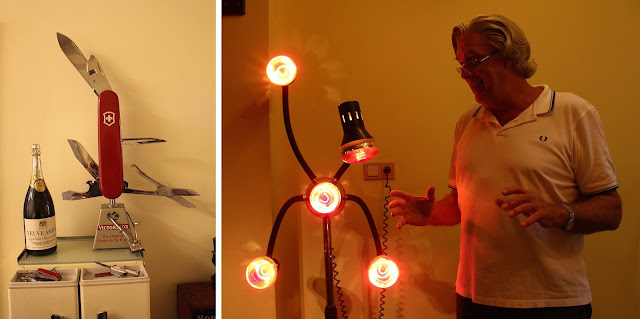 |
| sgraffito |
We arrived in Prague on a dismal cloudy day in October. No problem. Even on a cloudy day, this lively city is colorful and cheerful! Its ornate baroque buildings are washed in a pastel rainbow of colors. Some buildings are decorated with a two-toned sgraffito technique (where a surface layer of plaster is incised to reveal a lower layer of plaster in a contrasting color). Even the sidewalks are decorative, cobbled with patterns in shades of granite. Every neighborhood we explored was beautiful and well maintained. And there were crowds of people wherever we went, day and night. It's hard to imagine that this imaginative, spirited city was once under Communist rule.
 |
| Mosaic sidewalk patterns in old Prague |

Prague is a very photogenic city. Ancient towers, interesting buildings, and scenic views abound. A walk along Prague's riverfront is delightful, so many lovely things to see! Our hotel was on the eastern side of the Vltava, the river that divides Prague. High on a hill on the opposite bank is the magnificent Prague Castle, an awesome sight when viewed from the river.
 |
| Entry gate to Prague Castle |
 |
| St. Vitus Cathedral |
Prague Castle, founded in the 9th century AD, is a huge complex of buildings that covers more than 18 acres. St. Vitus Cathedral dominates the castle and the skyline of the western bank of the river. The Castle has 3 large courtyards and a mix of buildings within its boundaries: palaces, churches, great halls, a monastery, towers, museums, art galleries, and the state apartments. Today, the president of the Czech Republic rules from the Castle.
 |
| Charles Bridge and its Old Town Bridge Tower, viewed from the Castle |
 |
| Wallenstein Palace |
Just below the Castle is the wonderful Wallenstein Palace and its gardens, created in the 17th century by Albrecht von Wallentstein. He was famous as the Commander-in-Chief of the Imperial forces during the Thirty Years War. Albrecht only lived in this beautiful place for a year before he was assassinated by order of Emperor Ferdinand II, who suspected him of treason. Now the Wallenstein Palace is home to the Czech Senate.
 |
| Cerny's In Utero |
There are statues everywhere in Prague...on rooftops, balconies, building corners, bridges, gates, and in the churches, of course. Many of them are from the baroque period, but Prague is famous for its contemporary public sculpture, too. Walking to the Old Town Square from our hotel we passed a 20 foot tall stainless steel sculpture of a naked woman, titled In Utero. It's the work of the Czech Republic's most famous contemporary sculptor, David Cerny. In Utero is an amusing, flashy counterpoint to its baroque surroundings.
Another of Prague's major tourist attractions is the Charles Bridge, named for King Charles IV, a 14th century emperor. Spanning the River Vltava, this 400+ year old concoction is decorated with 30 statues!
 |
| Crossing the Charles Bridge, heading for Prague's "Little Quarter." |
 |
| St. John Nepomuk |
One of the statues has a halo of 5 golden stars. This is the martyred St. John Nepomuk, who was thrown off the bridge in March of 1393- punishment for displeasing King Wenceslas IV. John's unique halo commemorates the 5 stars that hovered over the Vltava River on the night of his death.
 |
| The Old Town Hall's Astronomical Clock |
Prague's history is littered with the untimely deaths of people being thrown off of or out of somewhere! In fact, there are incidents in Prague's history officially called The Defenestrations. This interesting term is defined as "an act of throwing someone or something out of the window." The first Prague Defenestration took place in 1419 when radical Czech Hussites (followers of murdered Czech religious hero Jan Hus) threw 7 city council members from the Town Hall's windows. Those who survived the fall were murdered by the angry mob below.
 |
| Site of 2nd Defenestration |
The Second Prague Defenestration happened at the Old Royal Palace of Prague Castle in 1618, the result of another religious disagreement. It ended on a happier note. The 3 Catholics who angry Protestants threw out of a second storey window at Prague Castle survived the fall. Catholics claimed that the men survived because they were caught by angels; Protestants insisted that their fall was cushioned by the pile of manure they landed on:)
 |
| U Fleku, a great way to end our Prague adventure! |
On our last evening in the city we enjoyed a hearty roast pork and dumplings meal at Prague's Pivovar U Fleku (U Fleku Brewery), which was founded in 1499. This is a cozy, noisy place. Dark wood paneling lined the walls of our dining room, and an accordion player roamed between the tables singing traditional Czech songs. We sat at a long wooden table with other diners. The food was great, as was the signature U Fleku dark beer.























































